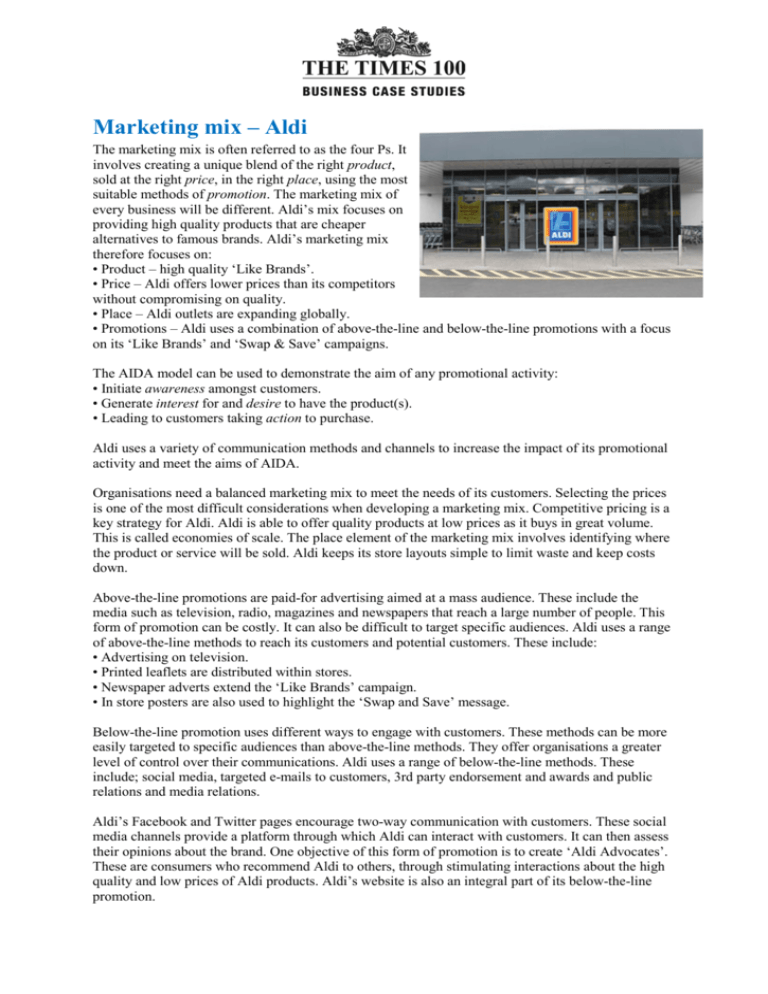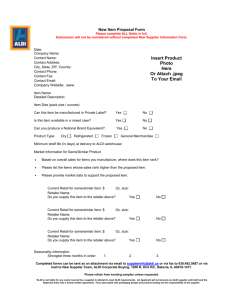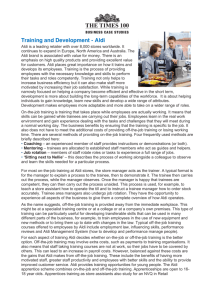Marketing mix – Aldi - Business Case Studies
advertisement

Marketing mix – Aldi The marketing mix is often referred to as the four Ps. It involves creating a unique blend of the right product, sold at the right price, in the right place, using the most suitable methods of promotion. The marketing mix of every business will be different. Aldi’s mix focuses on providing high quality products that are cheaper alternatives to famous brands. Aldi’s marketing mix therefore focuses on: • Product – high quality ‘Like Brands’. • Price – Aldi offers lower prices than its competitors without compromising on quality. • Place – Aldi outlets are expanding globally. • Promotions – Aldi uses a combination of above-the-line and below-the-line promotions with a focus on its ‘Like Brands’ and ‘Swap & Save’ campaigns. The AIDA model can be used to demonstrate the aim of any promotional activity: • Initiate awareness amongst customers. • Generate interest for and desire to have the product(s). • Leading to customers taking action to purchase. Aldi uses a variety of communication methods and channels to increase the impact of its promotional activity and meet the aims of AIDA. Organisations need a balanced marketing mix to meet the needs of its customers. Selecting the prices is one of the most difficult considerations when developing a marketing mix. Competitive pricing is a key strategy for Aldi. Aldi is able to offer quality products at low prices as it buys in great volume. This is called economies of scale. The place element of the marketing mix involves identifying where the product or service will be sold. Aldi keeps its store layouts simple to limit waste and keep costs down. Above-the-line promotions are paid-for advertising aimed at a mass audience. These include the media such as television, radio, magazines and newspapers that reach a large number of people. This form of promotion can be costly. It can also be difficult to target specific audiences. Aldi uses a range of above-the-line methods to reach its customers and potential customers. These include: • Advertising on television. • Printed leaflets are distributed within stores. • Newspaper adverts extend the ‘Like Brands’ campaign. • In store posters are also used to highlight the ‘Swap and Save’ message. Below-the-line promotion uses different ways to engage with customers. These methods can be more easily targeted to specific audiences than above-the-line methods. They offer organisations a greater level of control over their communications. Aldi uses a range of below-the-line methods. These include; social media, targeted e-mails to customers, 3rd party endorsement and awards and public relations and media relations. Aldi’s Facebook and Twitter pages encourage two-way communication with customers. These social media channels provide a platform through which Aldi can interact with customers. It can then assess their opinions about the brand. One objective of this form of promotion is to create ‘Aldi Advocates’. These are consumers who recommend Aldi to others, through stimulating interactions about the high quality and low prices of Aldi products. Aldi’s website is also an integral part of its below-the-line promotion. Questions 1. What are the four Ps? 2. Describe the purpose of promotion. 3. Explain the term above-the-line promotion, giving examples from the case study. 4. Analyse the reasons why Aldi may choose to use below-the-line methods of promotion in addition to mass-media advertising (above-the-line). Task Using the case study, your prior knowledge and any other research, write a report explaining how Aldi’s promotional activity allows the organisation to meet all of the AIDA criteria: • Increase awareness • Gain interest • Generate desire • Encourage action What have you learned? Word jumbles – jumble up some terms relating to the marketing mix and swap with a partner. Can you work out what the terms are?











